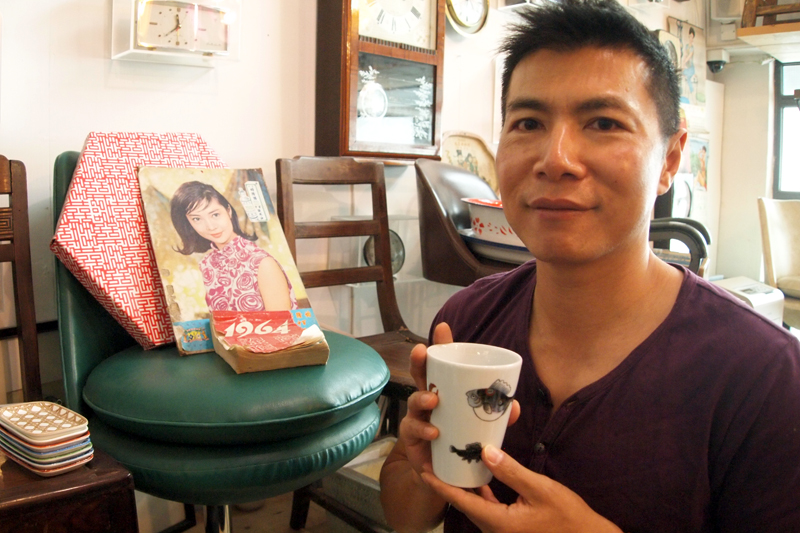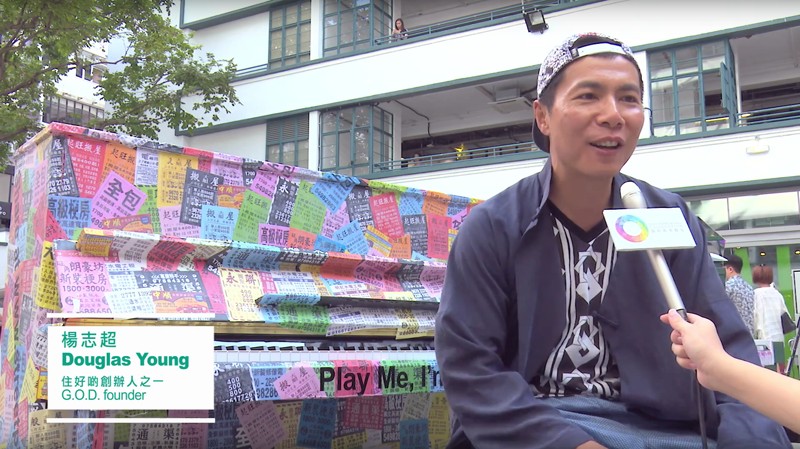
Local brand Goods Of Desire (G.O.D.) has long attracted attention in Hong Kong with its eye-catching designs featuring local culture and events, such as “Delay No More” T-shirts and fashion items with images from all around the city printed on them.
In an interview with HKFP, the brand’s founder Douglas Young Chi-chiu talked about the pro-democracy Occupy protest and the split it created in Hong Kong, and also discussed how we should view our culture.

During the summer, G.O.D. began selling a new T-shirt that says “I did it on Harcourt Road”. Inside the garment, it also said “I Occupied Central” with the brand’s logo. Young said the T-shirt was inspired by the protest, but was not itself a political statement and that it was up to people themselves to interpret what was done on Harcourt Road.
“I am just a designer and a creative person, I am inspired by things that happen around Hong Kong. If you know the brand, the brand is about Hong Kong. Things like our language, our culture, our history, even the Cultural Revolution. We have a lot of T-shirts, and Occupy Central was a big event, many people were somehow involved in it, so I guess it’s difficult not to use it as an inspiration, but we always do so in a humorous way. I don’t think the T-shirt was political in any way, I don’t think I was supporting or not supporting the movement.”
“The whole movement took over Hong Kong, it affected Hong Kong in so many ways. I think Harcourt Road was the centre of the whole event, and it was to do with my personal experience as well, because I was there. That’s why Harcourt Road was kind of the most awesome scene that I saw.”

Young said the T-shirt was not created for the anniversary of the protest; it has been on sale since June. He said the T-shirt was “a piece of art”, but that it did not have the same symbolic meaning as other art works which were made during the protest. In particular, he had wanted the Lennon Wall to stay.
“[It] was the most powerful of all the pieces that were done there, and it should been preserved in that exact location. These are not things that you just can move around, because if you take them out of context, you lose part of the meaning. I think the Lennon Wall was powerful because it was there in that building, which, as an architect, I consider very ugly.”

“The wall showed a softer side to the building, to me the building is like a fortress and the wall is like a human side, a side where people can leave their thoughts and their emotions. When it was still up, there was one public occasion when I saw Carrie Lam, and I actually went up to her and specifically asked if she would consider keeping that wall in its original location. If the government allowed that, it would show a side where it’s willing to listen. Because today the wall may be anti-government, but in ten years’ time, it may be about other things.”
He also thought that most of the messages were not actually about being anti-government but conveying the idea of “loving Hong Kong”, and that in time it could be a huge history book, that it would be a new tradition for Hong Kong.
Split in the city
However, not everyone liked the art or the protest itself.
“I do feel that Hong Kong is very split, and I do feel it’s not good that we have such opposing forces, because people are against each other, cancel each other out. I mean both sides are trying to do good, but because there are opposing forces, then a lot of effort is lost through the struggle, I think that’s bad.”
“One year on, I think we should be able to look back maturely and rationally, and see how we can move forward. I think it’s no good to keep on with the struggle because if Hong Kong doesn’t progress, then we are just kind of stagnating, lagging behind everywhere else.”

After the protest, he joined former Chief Executive Tung Chee-hwa’s Our Hong Kong Foundation and appeared in campaigns with it to “mend the rift in society”, but said he was “very sceptical” at first.
“I am very stupid when it comes to politics; as a politician I would never survive. But when I read the mission statement of what they wanted to do, which was to reach out to ‘unite Hong Kong’, I thought that was a very powerful statement, that was what I felt was needed for Hong Kong.”
He said the protest divided people, even artists, and that “it was stupid and wasteful” forcing people to choose sides. “I miss a lot of my friends, not because I don’t want to see them but they don’t want to see me. They think because I am doing this [for the Foundation], I must be one of those people.”
Young said both sides have been behaving well and badly at the same time, and he wanted them to “just shake hands”, although he knew he was “maybe very childish and naive”.

Proud of Hong Kong
He added that Hong Kong people should be proud of Hong Kong itself, and that its identity is built on many more things than politics.
“In Hong Kong, old things always get junked. We copy from overseas and we import, we have very little that is left that originated locally, maybe with certain exceptions, such as architecture and our language. I think it’s sad that we are losing our identity. Our real sense of identity is not to do with politics…we share our experiences, how we eat, how we dress, that we watched the same television back in the old days.”
He also said that his brand was being attacked on social media.
“They think that Hong Kong brands are not as good as French brands, they don’t see the need to support them. They also compare our prices, they think that we are quite expensive, but how can we be more expensive than French or Japanese brands? We are not cheap because we produce in small quantities.”

“We need to be strong as a community, if we are divided, we are going to be weak. We are not going to be conquered, but overtaken. As the saying goes, ‘two dogs strive for a bone, and a third runs away with it‘, if we are caught up in in-fighting, then we will not achieve anything, places like Singapore will overtake us, and actually they already have, in GDP.”
He said the Hong Kong government is not doing enough in supporting culture.
“In a way, whatever they [government officials] try to do will be attacked, and that’s not helping, is it? The government is spending a lot of time trying to defend itself, whereas I think our leaders should actually be working towards building our community and making it stronger, for example by promoting culture.”
“They need to provide leadership with vision, a sense of where Hong Kong could be, recognising the city’s strengths and weaknesses and working towards the vision. They should be able to lead a team from Hong Kong that thinks the same way and that will build Hong Kong. They also need to communicate to the people of Hong Kong that this is what Hong Kong could be.”
